January 24 Riverton (Day 119)
Another cold windy day so we didn’t do any walking, but we drove to the beach of Riverton, where the Pourakino River flows out to the Great Southern Ocean.

Way out in the distance on the right you can see a bump of land that is Stewart Island. The 3rd largest New Zealand Island, and the most southerly inhabited NZ island. There are groups of islands further south that are no longer inhabited.
We braved the cold wind briefly then headed back to our “Cute Cosy Hut”, and when those words are used it means “eclectic, tiny, outside toilet”! With no wifi, internet, or cell phone service, we were ‘roughing it’!

The landscaping has grown up around the hut, making it private and lush.
A large deck makes outdoor living possible, but not with the weather we had today! The deck connects the hut with the outdoor flush toilet in a small shed screened by bushes. The shower is around the corner from the front door and had great water pressure and lots of hot water! Occasionally birds would try to get into the shower room to nest under the roof.

The outdoor bathtub, big enough for 2, is raised above the main deck and overlooked by a horse who was there only part of our stay.

Outside the front door is the picnic deck looking towards the paddocks that marked the end of town.

And finally, the full moon rising over the trees to the northeast of the hut.
January 23 Moving Day (Day 118)
We woke to a cloudy drizzly day, great for a travel day. We’re moving to Riverton, way down on the south end of the South Island, an over 6 hour drive down the center of the island! We are going to go very close to Queenstown, the “Adventure Capital” of NZ so we decided we’ll stop to check it out. But first we drove through the small town of Cromwell, Otago District. Otago is becoming famous for its wineries and apparently its stone fruit orchards as well, as advertised by this giant sculpture! The peach, apricot and nectarine are joined by a pear, rounding out the fruit salad around Cromwell.
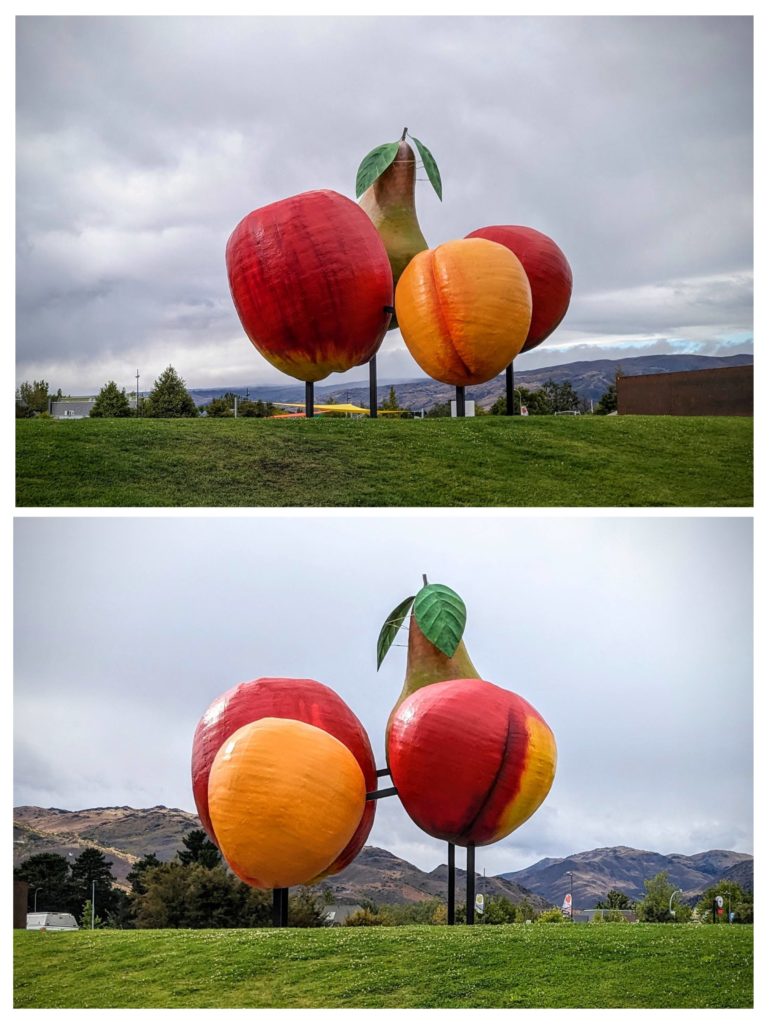
From this angle it looks like one of the colorful flightless birds around NZ!
We started up a mountain pass along a rushing river and stopped at a viewing platform at Roaring Meg. Roaring Meg is a turbulent stream that drives a hydro-electric power station and merges with the Kawarau River, which runs between the towns of Cromwell and Queenstown.

You can see the power station on the right, with the stream flowing out to the river.
We continued up and over the pass and down into Queenstown, seeing a line of cars for several kilometers leaving town! No matter what season, Queenstown is always busy it seems. We drove around looking for a parking space and finally found one about a 20 minute walk into town! Our destination was Fergburger! We had to try the iconic burgers! We figured out that it’s best to call in your order by phone rather than stand in line to order, then wait in line to pick up your burgers, especially on an unseasonably cold windy day like today! By the time we reached the restaurant we had only a 5 minute wait. They have very limited seating, so we headed outside to try and find a spot out of the wind to consume our burgers. Robert got the “Sweet Bambi” venison burger, while I opted for the “Ferg-lafel”, the falafel burger (I’ve had too much lamb lately – can you believe it!!).
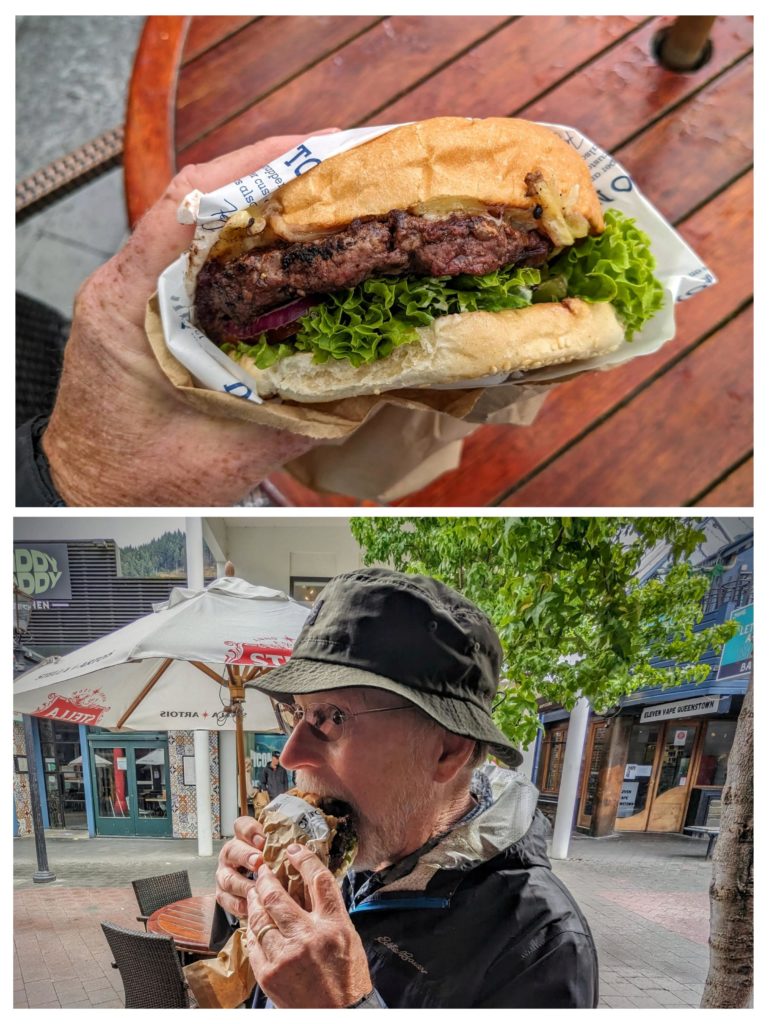
They are huge and delicious. I couldn’t finish mine and wrapped it up for later!
We walked around the lakefront back towards the car to finish our long driving day, we still had about 3 hours drive to Riverton!

A little bit of view at the lakefront. Queenstown is surrounded by mountains.
January 22, 2024 MacKenzie District (Day 117)
Fairlie is known as ‘The Gateway to the MacKenzie” and is on the edge of the MacKenzie District, just about center of the South Island, and a part of the Canterbury Region which is the largest region of the country by area. It includes the highest mountain and the largest intermountain basin in the country. 

How it came to be known as “MacKenzie Country” is an interesting story! The area was only intermittently inhabited by Maori before European colonization, mostly as a hunting area. In the early 1850’s a Scottish immigrant, James MacKenzie, came to New Zealand via Australia where he had emigrated to in 1849, not transported as a convict (convict transport eventually ceased in Australia in 1868)! In New Zealand he found work as a sheep drover as he awaited results of his land application which required that he stock the land with sheep. In March of 1855 he was found in an inland basin, previously unexplored by Europeans, with 1,000 sheep supposedly rustled from a wealthy sheep station owner on the east coast! He claimed innocence and managed to escape only to be arrested in Lyttleton near Christchurch, some 100 miles away. In April he was convicted and sentenced to 5 years hard labour for sheep-stealing. He managed to escape several more times, even being shot in one instance. Eventually his case was investigated by a new magistrate who “…found that the police inquiry and the trial had been seriously flawed, and with the support of…a Superintendent, secured a free pardon for Mackenzie in January 1856.” After only 9 months of imprisonment MacKenzie was free, he made a quick getaway back to Australia it is assumed, but nothing is known of his later life. His legacy grew with the telling of his story and the significance of the inland pass and basin he was the first to utilize was quickly appreciated! “Small would-be farmers wanting their own land or resenting the power of large wealthy landowners could identify with him, as could those who did not fit the mould of genteel Canterbury society.” Remember, New Zealand was colonized by willing immigrants, no one was forced through slavery, penal conviction or indentured servitude to come to these shores! In fact many British immigrants were wealthy speculators or retiring military career pensioners, and they wanted hard-working peasant laborers! Eventually the high alpine basin was named in honor of the rebellious folk hero, and even his shepherd dog (probably a border collie) gained notoriety!

A statue has been erected in Fairlie in honor of James MacKenzie and his dog!
January 21, 2024 Aoraki/Mount Cook (Day 116)
A glorious day for a road trip, in fact the best day of the week for our destination; Aoraki/Mount Cook, the highest mountain in NZ at 12,218 feet. It is a 2 hour drive from our accommodation so we got up around 4am to have breakfast and pack our day packs to leave by 6am!

Our planned route from Fairlie to Aoraki/Mt. Cook.

On the road, we saw the alpenglow on the hills as the sun rose through the clouds.
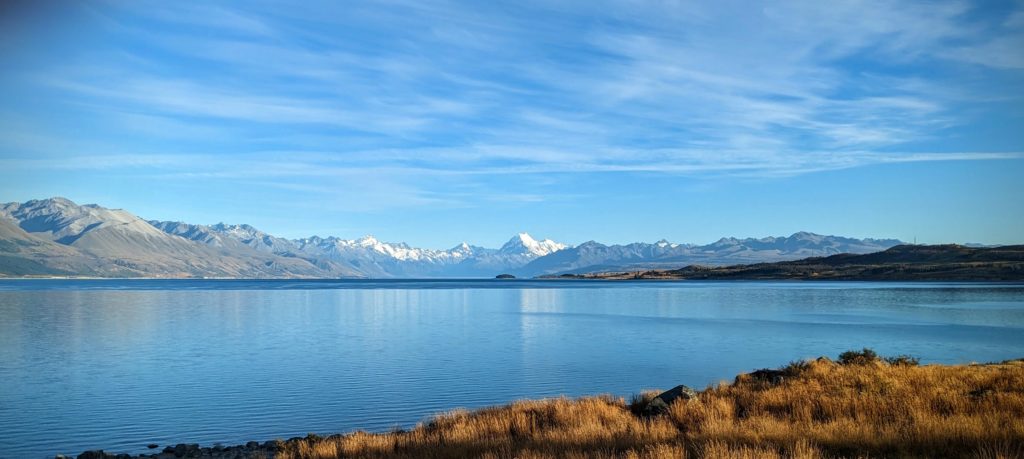
As we rounded the bottom of Lake Tekapo we stopped at a viewpoint of the mountain overlooking the lake.

Continuing on we rounded Lake Pukaki and drove north up the west side of the lake. We saw great big rows of slash and distant stands of burnt pine forest. At a rest area we found out that “…wilding conifers have spread from erosion plantings, farm shelterbelts and plantation forests into the surrounding countryside. If not managed these trees quickly form impenetrable forests of no economic value. They make farms unusable, take over native ecosystems, use scarce water and alter iconic landscape”. These forests are being controlled with herbicide and chainsaws. The land is then restored to productive farmland (more like rangeland), and encouraged to regrow in native plants.

As we approached closer the flat-bottomed glacial valley spread out beside us.

Finally we reached the parking lot at Hooker Valley which was quickly filling with early morning hikers!
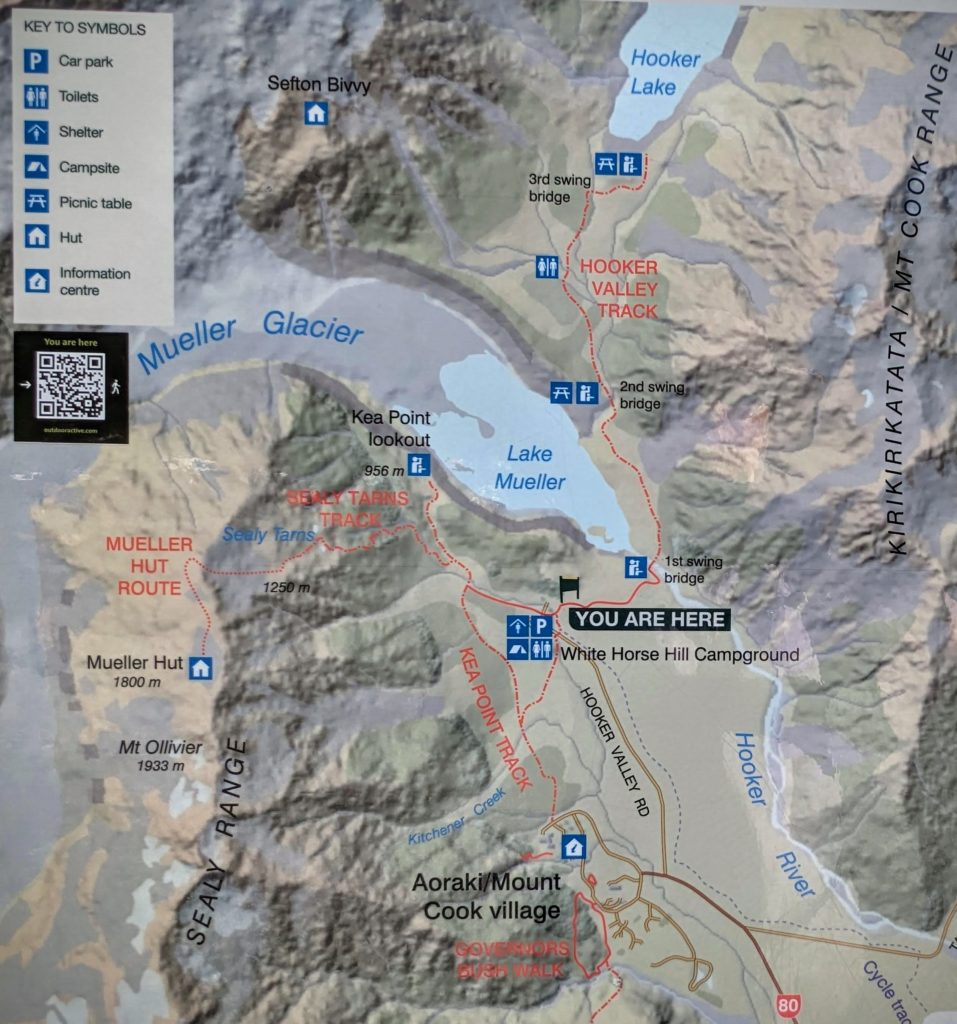
The Hooker Valley Track is one of the most popular walks in New Zealand, probably because it’s a pretty easy walk, especially on such a beautiful day as today!

Near the start of the trail is the first of 3 suspension bridges. Apparently they are closed overnight because a crowd was starting to form waiting for the gate to be unlocked at 9am!

The second bridge was still in the morning shade cast by the mountains on the east side of the Tasman river.

The final bridge has fantastic views of Aoraki/Mt. Cook!

We finally reached Hooker Lake, with Aoraki/Mt. Cook in all it’s glory! The reality of the crowds reaching this point, with many more to come!

The ‘Instagram’ view sans crowds!

After our 3+ hour hike we went to the Hermitage Hotel cafe for coffees and visited the exhibits about Sir Edmund Hilary, the New Zealander who was the first to summit Mt. Everest with Tenzig Norgay, a Nepalese Sherpa. Aoraki/Mt. Cook and the southern Alps were Hilary’s training ground!

As we left Hooker Valley and Aoraki/Mt. Cook Village we got this great panorama of this small piece of the Southern Alps.
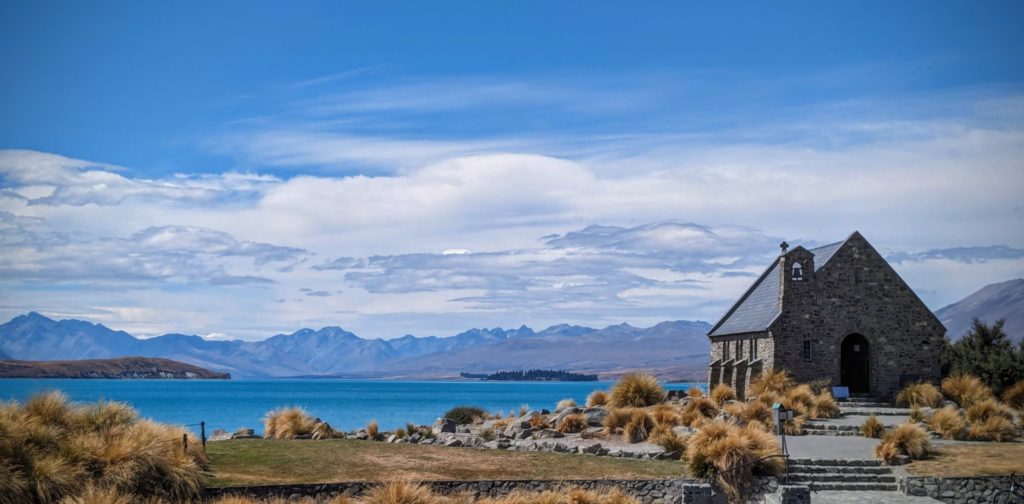
And on our way back to Fairlie we took a detour into the town of Lake Tekapo to get the iconic photo of the Church of the Good Shepherd overlooking the lake towards the Southern Alps!
January 20, 2024 Kakahu Track (Day 115)
Another beautiful, hot day forecast for today. We got a slightly earlier start and drove a half hour east to the Kakahu Bush Track trailhead. You know you made it to the trailhead when you see the lime kiln. Built around 1876 and used intermittently until about 1900, it was used to burn limestone to produce burnt lime that was used for agriculture and the building industry. 
The Kakahu Track begins on the ridge behind the kiln and follows a beautiful creek through forest that progressively changes from non-native pines (looking like Ponderosa Pines!) and big oaks/maples to native Podocarp/Broadleaf forest. This section of forest is the last large remnant of the native lowland Podocarp hardwood forest in the Canterbury region. New Zealand has 2 main types of native forest, the Beech forest that we hiked through in the Nelson Lakes Nat’l. Park and the Kahurangi Nat’l. Park in the north end of the South Island, and the Podocarp/broadleaf forest found mainly on the North Island and in pockets of low lying areas of the South Island. On the more tropical North Island the Podocarp forest also harbors the prehistoric looking tree ferns. A third forest type was introduced in the mid 1800’s as a commercial crop, the true conifers that are usually planted in plantations.
We hiked up through the forest that was deafening with insect buzzes and static sounds. The clicking and crackling sounds were almost like live electricity lines running along the ground!

We emerged at the top near the ‘Pinnacles’ a limestone outcrop that we hiked around.
 After hiking around the pinnacles we hiked up to another outcrop viewpoint and could look east to the South Pacific Ocean! Hiking through sheep paddocks we re-entered the native forest, the large trees that emerge from the canopy are the native Podocarps, like this Kahikatea tree, which have cones and fruits.
After hiking around the pinnacles we hiked up to another outcrop viewpoint and could look east to the South Pacific Ocean! Hiking through sheep paddocks we re-entered the native forest, the large trees that emerge from the canopy are the native Podocarps, like this Kahikatea tree, which have cones and fruits.
We resumed hearing the deafening songs of the Cicadas, of which NZ has over 40 species! At one point they were so thick they were on the trunks of all the trees around us. I realized then that the ‘dust’ blowing and falling through the trees was not just leaf litter, but frass, bug poop! The light, papery specks covered the forest floor and blew all around us, a necessary component of a healthy forest! I just made a note to make sure I wash my hair thoroughly when we get home! The junction at the Balancing Rock closes the loop section of the trail and we began our downhill hike back to the kiln. We finished our hike, soaked in sweat, and had our picnic lunch before we headed back home for well deserved showers and a relaxing evening!






























 After hiking around the pinnacles we hiked up to another outcrop viewpoint and could look east to the South Pacific Ocean! Hiking through sheep paddocks we re-entered the native forest, the large trees that emerge from the canopy are the native Podocarps, like this Kahikatea tree, which have cones and fruits.
After hiking around the pinnacles we hiked up to another outcrop viewpoint and could look east to the South Pacific Ocean! Hiking through sheep paddocks we re-entered the native forest, the large trees that emerge from the canopy are the native Podocarps, like this Kahikatea tree, which have cones and fruits.